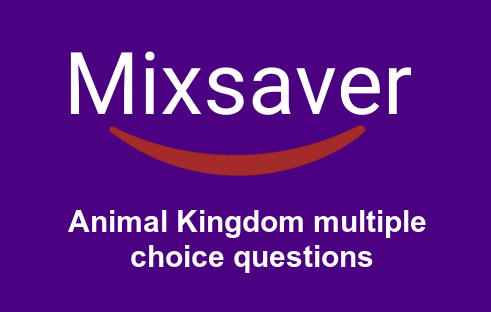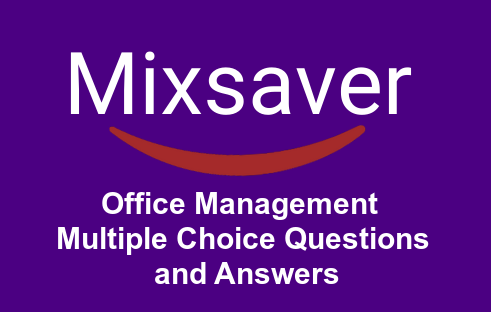1. Amoeboid protozoans move and capture their prey by
(a) putting out pseudopodia
(b) the ciliary movement
(c) the water currents
(d) None of these
Ans. a
2. The middle layer of the body wall of Porifera is an
(a) mesenchyme
(b) mesoderm
(c) mesogloea
(d) mesentery
Ans. a
3. Cnidarians exhibit
(a) tissue level of organisation
(b) diploblastic organisation
(c) central gastro-vascular cavity with a single opening
(d) All of the above
Ans. d
4. The main function of clitellum is
(a) cocoon formation
(b) locomotion
(c) excretion
(d) copulation
Ans. a
5. Taenia solium is commonly known as
(a) beef tapewórm
(b) pork tapeworm
(c) cattle tapeworm
(d) sheep tapeworm
Ans. b
6. The origin of the nephridium is
(a) germinal
(b) ectodermal
(c) mesodermal
(d) endodermal
Ans. c
7. Haemozoin granules, characteristic of malaria, are produced by
(a) toxins of Plasmodium
(b) haematin to haemoglobin
(c) endotoxin of Plasmodium
(d) None of the above
Ans. b
8. Cysts of E. histolytica spread by
(a) mosquito
(b) bed-bug
(c) mouse
(d) housefly
Ans. d
9. Sponges have a water transport or canal system, in which the path of water is
(a) osculum ostia spongocoel
(b) ostia Osculumspongocoel
(c) ostia spongocoelosculum
(d) osculum spongocoel ostia
Ans. c
10. Nematocyst are absent in
(a) Actinozoa
(b) Ctenophora
(c) Hydrozoa
(d) Scyphora
Ans. b
Animal Kingdom Class 11 neet Questions
11. Coral reefs are found in
(a) tropical and subtropical sea water
(b) shallow water
(c) deep water
(d) marine water below 70F temp
Ans. b
12. Intermediate host in liver fluke is
(a) snail
(b) pig
(c) man
(d) mosquito
Ans. a
13. The scientific name of precious red coral is
(a) Tubipora
(b) Fupgta
(c) Heliopora
(d) Corallium
Ans. d
14. In Leucosolenia, asexual reproduction take place by
(a) sporulation
(b) external budding
(c) binary fission
(d) cyst formation
Ans. b
15. The parasitic forms of flagellated protozoans cause diseases such as
(a) sleeping sickness
(b) maiaria
(c) Chaga’s disease
(d) leishmaniasis
Ans. a
16. Pseudopodia are formed in an Amoeba
(a) when it comes in contact with a food particle
(b) by the movement of the surrounding water
(c) by exchange of salts with the medium
(d) by sol-gel transformation of the cytopiasm
Ans. d
17. Sporozoa includes diverse organisms that have
(a) thousands of cilia on the body surface
(b) flagella on their body
(c) infectious spore-like stage in their life cycle
(d) silica shelis on their surface Amoeba is
Ans. c
18. The food capturing organelle
(a) food vacuole
(b) contractile vacuole
(c) pseudopodia
(d) nucleus
Ans. c
19. Chromatoid body in Entamoeba histolytica are found
(a) cyst
(b) trophozoite
(c) metacyst
(d) minuta
Ans. a
20. Exflagellation stage occurs in the life cycle of Plasmodium in
(a) man
(b) mosquito
(c) Both (a) and (b)
(d) None of these
Ans. b
21. A sponge can be distinguished from other animals due to presence of
(a) coelenteron
(b) choanocytes
(c) hollow body
(d) dermal papilae
Ans. b
22. Which cells in sponges have food reservest
(a) Archaeocytes
(b) Myocytes
(c) Thesocytes
(d) Choanocytes
Ans. c
23. Select the odd one from the following
(a) Sycon
(b) Spongila
(c) Euspongia
(d) Adamsia
Ans. d
24. Fertilisation in sponge is
(a) internal
(b) extermal
(c) Both (a) and (b)
(d) None of these
Ans. a
25. Excretion process in Entamoeba histolyticatakes place by
(a) general surface
(b) contractile vacuole
(c) food vacuoles
(d) None of the above
Ans. a
26. Cyclosis in Paramecitum is associated with
(a) respiration
(b) excretion
(c) digestion
(d) locomotion
Ans. d
27. Which organism possesses characteristics of plants and animals?
(a) Bacteria
(b) Monera
(c) Eugiena
(d) Mycoplasma
Ans. c
28. Collar cells are general characteristic of
(a) sand worm
(b) roundworms
(c) Coelenterata
(d) sponges
Ans. d
29. Which of the following statements is true about roundworms?
(a) Roundworms may reach 5 cm in length
(b) They are non-segmented
(c) They are generally dark coloured
(d) They occur only in the sail
Ans. b
30. Which kind of symmetry occurs in sea anemone?
(a) Bilateral
(b) Radial
(c) Asymmetry
(d) None of these
Ans. b
Animal Kingdom MCQ for NEET pdf
31. In a sponge which of the following are responsible for maintaining the current of water?
(a) Pinacocytes
(b) Porocytes
(c) Choanocytes
(d) Amoebocytes
Ans. c
32. Which one is the freshwater sponge?
(a) Spongia
(b) Sycon
(c) Euplectella
(d) Spongilla
Ans. a
33. The members of phylum-Coelenterata show
(a) metamerism
(b) radial symmetry
(c) bilateral symmetry
(d) asymmetry
Ans. b
34. The totipotent cells of sponge are
(a) archaeocytes
(b) pinacocytes
(c) choanocytes
(d) trophocytes
Ans. a
35. Active feeding stage of Plasmodium is
(a) trophozoite
(b) sporozoite
(c) merozoite
(d) metacryptozoite
Ans. a
36. Centrosomes are absent in
(a) Amoeba
(b) Paramecium
(c) Trypanosoma
(d) Plasmodium
Ans. a
37. Tse-tse fly is the vector of
(a) typhoid
(b) kala-azar pioydki
(c) gambian fever
(d) oriental sore
Ans. c
38. Onchosphere embryo occurs in
(a) Paramecium
(b) Taenia solium
(c) Fasciola
(d) Ascaris
Ans. b
39. Metacercaria larvae is the characteristic feature of
(a) Fasciola
(b) Schistosoma
(c) Both (a) and (b)
(d) None of these
Ans. a
40. In Paramecium, the coordinated movement of row of cilia causes the water laiden with food to be
(a) expelled out fro.m the cell
(b) steered into the gullet
(c) cycled into the protoplasm
(d) None of the above
Ans. b
MCQ on Chordates | Animal Kingdom MCQ pdf | Phylum Chordata Questions Answers
41. Sleeping sickness is caused by
(a) Trypanosoma gambiense
(b) Entamoeba histolytica
(c) Plasmodium vivax
(d) Plasmodium ovale
Ans. a
42. Velerium is found in
(a) Aurelia
(b) Obelia medusa
(c) Sertularia
(d) Hydra
Ans. a
43. The study of coelenterates is known as
(a) Arthrology
(b) Splanchnology
(c) Cnidology
(d) Nidology
Ans. c
44. Reserved food in Euglena is in the form of
(a) starch
(b) glycogen
(c) fatty acids
(d) paramylum
Ans. d
45. The hinder end of male Ascaris is
(a) straight
(b) thickened
(c) coiled
(d) curved
Ans. d
46. Characteristic common feature between flatworms and roundworms is
(a) triploblastic
(b) acoelomate
(c) pseudocoelomate
(d) parasitic
Ans. a
47. The commonest worm in children is
(a) Ascaris lumbricoides
(b) Enterobius vermicularis
(c) Ancylostoma duodenale
(d) Trichinella sprialis
Ans. b
48. Whipworm is
(a) Trichuris
(b) Ancylostoma
(c) Enterobius
(d) Trichinella
Ans. a
49. Liver fluke belongs to class
(a) Trematoda
(b) Turbellaria
(c) Castoda
(d) Nematoda
Ans. a
50. Segments of tapeworm are called
(a) scoles
(b) cysticercus
(c) proglottides
(d) onchospheres
Ans. c
Kingdom Animalia MCQs pdf | Animal Kingdom NEET Questions pdf Download | MCQ on Chordates pdf
51. Jelly fishes belong to class
(a) Nydrozoa
(b) Scyphozoa
(c) Anthozoa
(d) None of these
Ans. b
52. Choanocytes are present in
(a) incurrent canals
(b) radial canals
(c) excurrent canals
(d) spongocoel
Ans. c
53. Tentacles of Hydra are
(a) hollow
(b) soud
(c) half hollow
(d) None of these
Ans. a
54. Nutrition in Ascaris is
(a) molozoic
(b) saprozoic
(c) parasitic
(d) Both (b) and (c)
Ans. a
55. The colour of Spongilla is due to
(a) chromocytes
(b) zoochlorellae
(c) zooxanthellae
(d) Both (a) and (b)
Ans. b
56. Ciliated protozoans have a cavity, that opens outside of the cell surface are called
(a) contractile vacuole
(b) food vacuole
(c) gullet
(d) anus
Ans. c
57. Sporozoa includes diverse organisms that have
(a) thousands of cilia on the body surface
(b) flägella on their body
(c) infectious spore-like stage in their life cycle
(d) silica shells on their surface
Ans. c
58. Centrosomes are absent in
(a) Amoeba
(b) Paramecium
(c) Trypanosoma
(d) Plasmodium
Ans. a
59. The infective stage of Trypanosoma is
(a) long and slender form
(b) crithidial form
(c) metacyclic form
(d) intermediate form
Ans. c
60. Osmoregulatory mechanism is absent in
(a) Paramecium
(b) Amoeba
(c) Euglena
(d) Trypanosoma
Ans. d
mcq on animal kingdom for neet pdf | animal kingdom mcq pdf download | chordates mcqs with answers pdf
61. Amoeba reacts
(a) negatively to both weak and strong light
(b) positively to strong light and negatively to weak light
(c) positively to both weak and strong light
(d) negatively to strong light and positively to weak light
Ans. d
62. Amoeba is immortal, it can be explained by germplasm theory of
(a) Heitzmann
(b) Schultze
(c) Berthold
(d) Weismann
Ans. d
63. Surface tension theory explains the theory of
(a) amoeboid movement
(b) caterpillar movement of Hydra
(c) ciliary beat
(d) jerking movement of Euglena
Ans. a
64. Amoeba is capable of regeneration. This is possible only from
(a) a nucleated bit of Amoeba
(b) an anucleate bit of Amoeba
(c) a young Amoeba
(d) an old Amoeba
Ans. a
65. Balantidium lives in the intestine of
(a) man
(b) pig
(c) sheep
(d) All of these
Ans. d
66. Cytopyge is found in
(a) Amoeba
(b) Paramecium
(c) Euglena
(d) Trypanosoma
Ans. d
67. Which show endocommensal form in large intestine of anura?
(a) Opalina
(b) Monocystis
(c) Trypanosoma
(d) None of these
Ans. a
68. Active feeding stage of Plasmodium is
(a) trophozoite
(b) sporozoite
(c) merozoite
(d) metacryptozoite
Ans. a
69. Destruction of nucleus in Amoeba results in
(a) no change
(b) quick locomotion
(c) slowing down of metabolism
(d) immediate death
Ans. c
70. If an Amoeba is put in a medium-A from freshwater, its contractile vacuole disappeared but when it is transferred to medium-B, its contractile vacuole reappeared. What is the difference between medium-A and B?
(a) Medium-A is hypotonic
(b) Medium-B is hypertonic
(c) Medium-A is hypertonic
(d) Medium-A is isotonic
Ans. d
Animal Kingdom NEET MCQ pdf | Animal Kingdom Non Chordates MCQ NEET | Multiple Choice Questions on Phylum Chordata
71. Nitrogenous wastes in Amoeba, are excreted through
(a) plasmalemma
(b) food vacuole
(c) contractile vacuole
(d) None of these
Ans. a
72. In sponges, the canal system is helpful in
(a) food gathering
(b) respiratory exchange
(c) removal of waste
(d) All of these
Ans. d
73. Select the odd one from the following.
(a) Sycon
(b) Spongilla
(c) Euspongia
(d) Adamsia
Ans. d
74. The middle layer of the body wall of Porifera is
(a) mesenchyme
(b) mesoderm
(c) mesogloea
(d) mesentery
Ans. a
75. Glass sponges belong to the class
(a) Demospongia
(b) Tetractinellida
(c) Hexactinellida
(d) Calcarea
Ans. c
76. Which one of the following is the most distinctive character of sponges? ablons/
(a) They are acellular
(b) They possess special cells called choanocytes
(c) They reproduce asexually
(d) They are all marine
Ans. b
77. The inter-communicating cavities in the body of a sponge constitute
(a) water vascular system
(b) canal system
(c) circulating system
(d) None of these
Ans. b
78. Which of the following statement is true about sponges?
(a) Innumerable mouths and one exit
(b) One mouth and innumerable exits
(c) Spicules are made of chitin
(d) A large spaceous stomach
Ans. a
79. Which of the following is a false statement?
(a) All sponges are hermaphrodites
(b) Choanocytes are reproductive in function
(c) Sponges are multicellular organisms
(d) Porocytes allow incurrents of water
Ans. b
80. Porocytes are special cells for the passage of
(a) excretory products within body of flatworms
(b) sweat upon surface of mammalian epidermis
(c) incoming water current in the body of sponges
(d) outgoing water current on top of sponges
Ans. c
Higher Non-Chordates MCQs
1. Body of annelids is
(a) bilateral symmetrical
(b) asymmetrical
(c) radial symmetrical
(d) None of the above
Ans. a
2. The parapodia of heteronereis are
(a) provided with long, thicker bar-shaped blades
(b) shorter than the parapodia of Nereis
(c) longer than body segments
(d) provided with thin cartilaginous covering for strength
Ans. a
3. In Echinodermata, fertilisation is usually
(a) external
(b) internal
(c) absent
(d) useless
Ans. b
4. Statocysts are
(a) present in heteronereis
(b) absent in adult Nereis
(c) present in larval forms only
(d) totally absent in Nereis
Ans. d
5. In echinoderms, the digestive system is
(a) complete
(b) incomplete
(c) absent
(d) Either (b) or (c)
Ans. a
6. Apple snail is the common name of
(a) Octopus
(b) Ampullariidae
(c) Dentalium
(d) Loligo
Ans. b
7. In prawn, identification of sex can be done externally by
(a) second chelate leg
(b) first abdominal appendage
(c) first maxillipeds
(d) uropode
Ans. d
8. Gastropods are
(a) marine
(b) freshwater
(c) terrestrial
(d) All of these
Ans. d
9. The larva of echinoderms are
(a) radially symmetrical
(b) bilaterally symmetrical
(c) asymmetrical
(d) pentamerous
Ans. b
10. Resorptive cells of digestive gland of Pila possess
(a) lipases
(b) proteases
(c) carbohydrates
(d) None of these
Ans. b
11. Echinoderms have an endoskeleton of
(a) calcified bones
(b) calcareous ossicles
(c) chitinous plates
(d) spongin fibres
Ans. b
12. The most evolved molluscs are
(a) cephalopods
(b) gastropods
(c) scaphopods
(d) None of these
Ans. a
14. Ecdysis and metamorphosis is controlled by which of the following glands in cockroach?
(a) Corpus luteum
(b) Corpora allata
(c) Corpus callosum
(d) Prothoracic gland
Ans. b
15. Body of molluscs is covered by
(a) chitinous exoskeleton
(b) siliceous spicules
(c) calcareous shell
(d) pellicle
Ans. c
16. The level of organisation in Echinodermata is of
(a) cellular level
(b) tissue level
(c) organ level
(d) organ system level
Ans. d
17. Lime cells of digestive glands in Pila contain
(a) carbonates of lime
(b) sulphate of lime
(c) phosphate of lime
(d) All of these SE
Ans. c
18. What is correct about male mosquito?
(a) Mandibles are well-developed
(b) Mandibles are four
(c) Mandibles are absent
(d) None of the above
Ans. c
19. In molluscs, the digestive tract
(a) absent
(b) complete
(c) incomplete
(d) None of these
Ans. b
20. Filter feeding occurs in
(a) earthworm
(b) Nereis
(c) leech
(d) cockroach
Ans. a
21. ‘Acorn worm’ is the common name of
(a) Balanoglossus
(b) Ascaris
(c) Earthworm
(d) Scolopendra
Ans. a
22. Haemocyanin, the blue colouring pigment of molluscan blood contains
(a) iron
(b) magnesium
(c) copper
(d) manganese
Ans. c
23. Mollusca has….type of vascular system
(a) reduced
(b) open
(c) closed
(d) None of these
Ans. b
24. The culture of molluscs can be studies under
(a) pisciculture
(b) sericulture
(c) aquaculture
(d) apiculture
Ans. c
What is Chordata and Non Chordata | Phylum Chordata Questions Answers
25. Johnston’s organ is found in
(a) spider’s
(b) antennae of mosquitoes
(c) head of cockroach
(d) abdomen of houseflies
Ans. b
26. Echinoderms are considered to be the most evolved invertebrates because they
(a) are schizocoelic
(b) are enterocoelic
(c) have a great power of regeneration
(d) show resemblance with chordates in their embryonic development
Ans. a
27. How many red colour eye spots are present in sea star?
(a) One pair
(b) Two pairs
(c) Three pairs
(d) Five pairs
Ans. d
28. Excretion in echinoderm is conducted by
(a) a set of nephridium around the disc
(b) a set of nephridium around the tips of arms
(c) echinoderms are without excretory organs
(d) five pairs of kidney
Ans. c
29. What are the respiratory organs of molluscs?
(a) Gills of ctenidia
(b) Mantle
(c) Pulmonary sac
(d) All of these
Ans. d
30. A snail’s body has
(a) visceral mass
(b) shell
(c) ventral muscular foot
(d) All of these
Ans. d
31. One of the following is not an echinoderm
(a) sea lily
(b) sea pentagon
(c) sea pen
(d) sea cucumber
Ans. c
32. The fold of dorsal body wall covering the visceral mass in Mollusca is known as
(a) shel
(b) mantle
(c) operculum
(d) None of these
Ans. b
33. The echinoderms are related to chordates by its similarity in the development of
(a) gut
(b) nerve
(c) coelom
(d) heart
Ans. c
34. Mollusca are
(a) bilaterally symmetrical
(b) radial symmetrical
(c) asymmetrical
(d) None of these
Ans. a
35. Mollusca have..type of reproduction.
(a) asexual
(b) sexual
(c) Both (a) and (b)
(d) None of these
Ans. b
36. Torsion and detorsion are exceptional to
(a) Mollusca
(b) Echinodermata
(c) Annelida
(d) All of these
Ans. a
37. Locomotory organs of Echinodermata are
(a) parapodia
(b) pseudopodia
(c) toot
(d) None of these
Ans. d
38. Nervous system of echinoderms comprises
(a) radial nerve cord
(b) the presence of brain
(c) no brain
(d) chain of ganglia
Ans. a
39. The members of bee colony recognise each other by
(a) smell
(b) vision
(c) touch
(d) dance
Ans. d
40. The common larvae of annelids is
(a) trochophore
(b) actinotrocha
(c) tornaria
(d) None of these
Ans. a
41. Coelomic fluid of Pheretima is
(a) acidic
(b) watery
(c) oily
(d) alkaline
Ans. d
42. Nereis
(a) gregarious
(b) nocturnal
(c) carnivorous
(d) All of these
Ans. d
43. The female genital aperture in earthworm is present ventrally on the segment
(a) 10th
(b) 12th
(c) 14th
(d) 19th
Ans. c
44. An insect commonly available from book is
(a) silver fish
(b) Drosophila
(c) cockroach
(d) mosquito
Ans. a
45. A class with the largest number of animals is
(a) Mammalia
(b) Insecta
(c) Reptilia
(d) Pisces
Ans. b
46. Changes involving conversion of larva into adult are
(a) metastasis
(b) metagenesis
(c) metamorphosis
(d) alternation of generation
Ans. c
47. The Indian pearl oyster is
(a) Sepia
(b) Pinctada
(c) Pila
(d) Chiton
Ans. b
48. Connecting link between Annelida and Mollusca is
(a) Squid
(b) Nautilus
(c) Neopilina
(d) Sepia
Ans. c
49. The larvae of echinodermates are
(a) trochophore and auricularia
(b) bipinnavia and brachiolaria
(c) radia and cerearia
(d) miracidium and cysticerci
Ans. b
50. Sea star is
(a) Asterias
(b) Ophiothrix
(c) Anedon
(d) Echinus
Ans. a
51. Which one of the following are not hermaphrodite animals?
(a) Polychaetes
(b) Flatworms
(c) Leeches
(d) Earthworm
Ans. a
52. The animal which does not show any metamorphosis of larval stage is
(a) Pheretima posthuma
(b) Astrias
(c) Musca domestica
(d) Butterfly
Ans. a
53. Leeches are
(a) phytophagous animals
(b) blood sucking animals
(c) insectivorous animals
(d) soil eating animals
Ans. b
54. Leech secretes, which of the following anticoagulants?
(a) Hirudin
(b) Heparin
(c) Serotonin
(d) Histamine
Ans. a
55. Which one assists in locomotion?
(a) Trichocysts in Paramecium
(b) Penae spicules in Ascaris lumbricoidis
(c) Clitellum in Pheretima
(d) Posterior sucker in Hirudinaria
Ans. d
56. Tube dwelling polychaetes are known as
(a) burrowing
(b) planktonic
(c) pelagic
(d) tubicolous
Ans. d
57. Aphrodite is commonly known as
(a) lung worm
(b) sea fan
(c) sea mouse
(d) polalo worm
Ans. c
58. Which of the following annelid is dioecious?
(a) Pheretima
(b) Eisenia
(c) Nereis
(d) Lumbricus
Ans. c
59. Clitellum is absent in
(a) Nereis
(b) Aphrodite
(c) Chaetopterus
(d) All of these
Ans. d
60. Which one of the following larva is shared by both annelids and molluscs?
(a) Glochidium
(b) Tornaria
(c) Trochophore
(d) Planula
Ans. c
61. The largest phylum of Animalia, that includes insects is
(a) Arthropoda
(b) Aschelminthes
(c) Porifera
(d) Annelida
Ans. a
62. The body of arthropods consists of
(a) head
(b) thorax
(c) abdomen
(d) All of these
Ans. d
63. In arthropods, excretion takes place through the
(a) flame cells
(b) Malpighian tubules
(c) gills
(d) nephridia
Ans. b
64. In arthropods, fertilisation is usually
(a) internal
(b) external
(c) absent
(d) Either (b) or (c)
Ans. a
65. The membrane at the side that can connect the tergum and sternum is called
(a) mesentery
(b) pleuron
(c) epithelium
(d) chitin
Ans. b
66. The balancing organ equal to our ear in aquatic arthropods as in prawn is
(a) otolith
(b) lateral line organ
(c) otocyst
(d) statocyst
Ans. d
67. The free larval stage can be traced in which one of the following sets?
(a) Ascaris, housefly and earthworm
(b) Butterfly mosquito and honeybee
(c) Housefly, earthworm and mosquito
(d) Locust, earthworm and cockroach
Ans. b
68. Head louse is
(a) Pediculus humanus capititis
(b) Phytophaga
(c) Pediculus humanus corporis
(d) None of the above
Ans. a
69. In Limulus (king crab), belonging to sub-class-Xiphosura, the respiratory organs are
(a) book lungs
(b) gills
(c) tracheae
(d) absent
Ans. a
70. Respiratory organs of crustaceans are
(a) lungs
(b) book lungs
(c) tracheae
(d) gills
Ans. d
71. The coxal glands in arachnids serve as
(a) digestive glands
(b) excretory glands
(c) reproductive glands
(d) poison glands
Ans. b
72. An insect without metamorphosis is
(a) silver fish
(b) Pediculus
(c) bed bug
(d) cray fish
Ans. a
73. Leptocorisa is
(a) harmful
(b) useful
(c) important in oil industry
(d) useful for crops as biological control
Ans. a
74. Phlebotomus is responsible for spreading
(a) dumdum fever
(b) oriental sores
(c) kala-azar
(d) All of these
Ans. d
75. Palpigers are the structures present on insect’s
(a) labrum
(b) labium
(c) antennae
(d) maxillae
Ans. b





